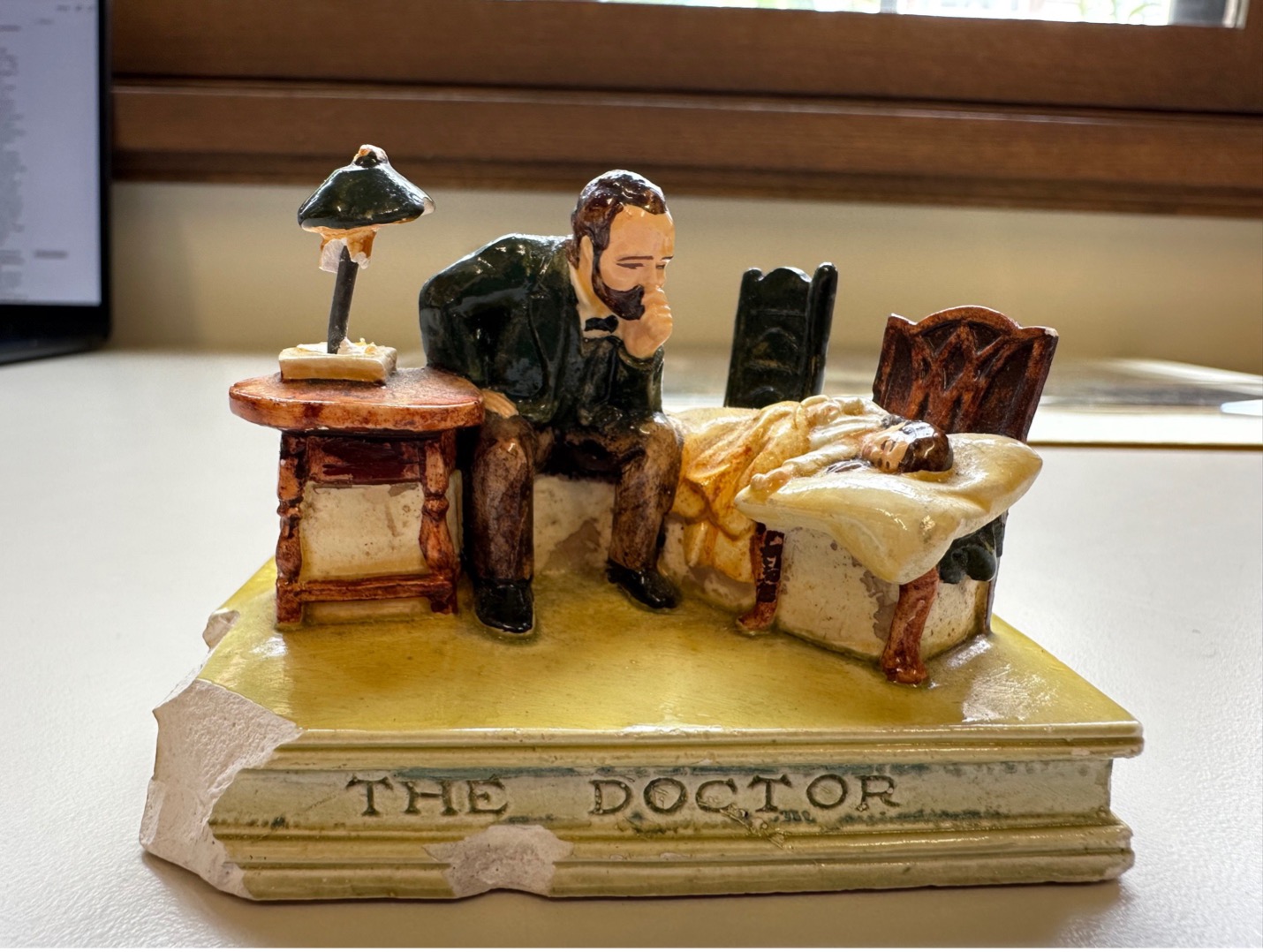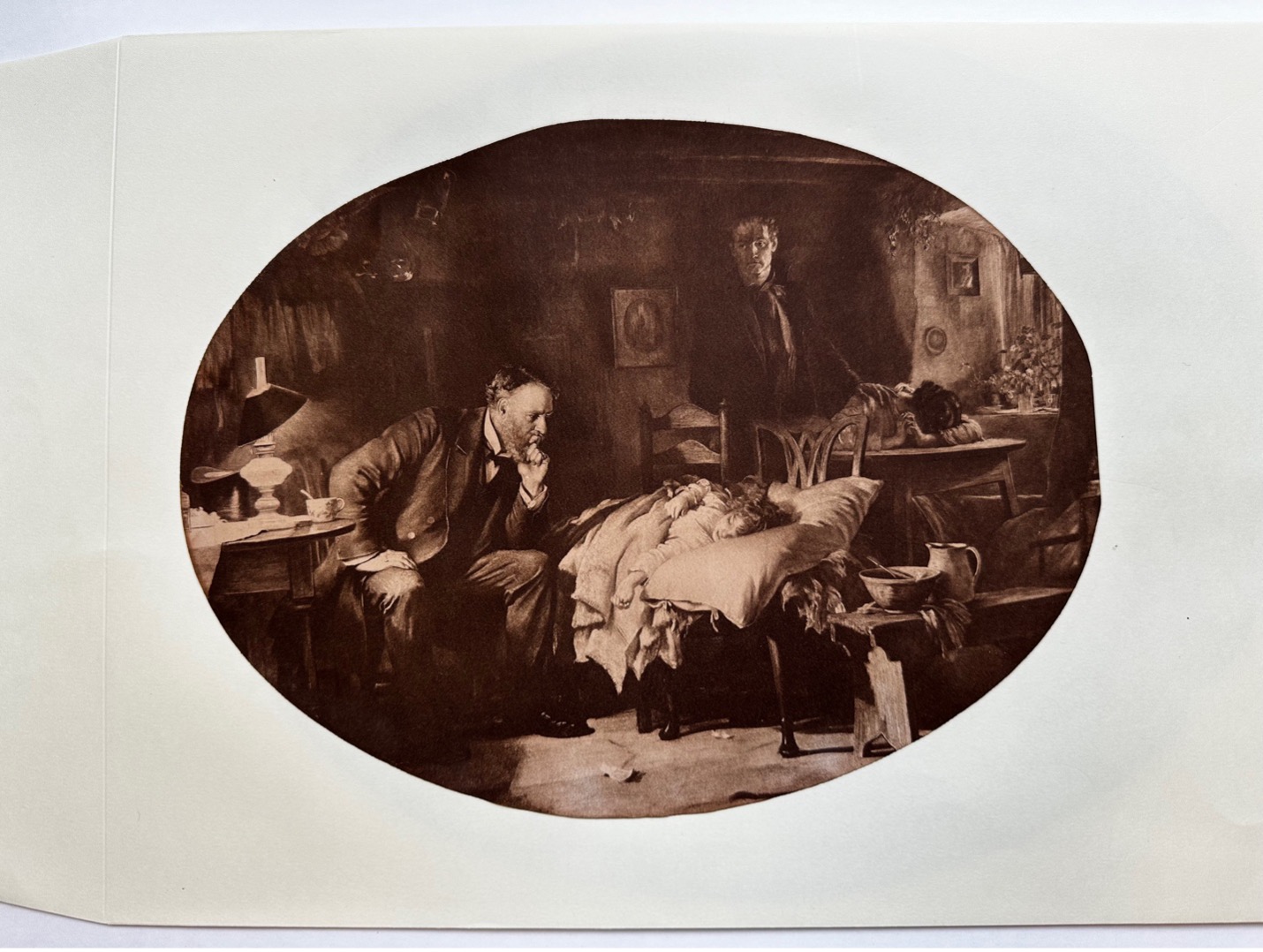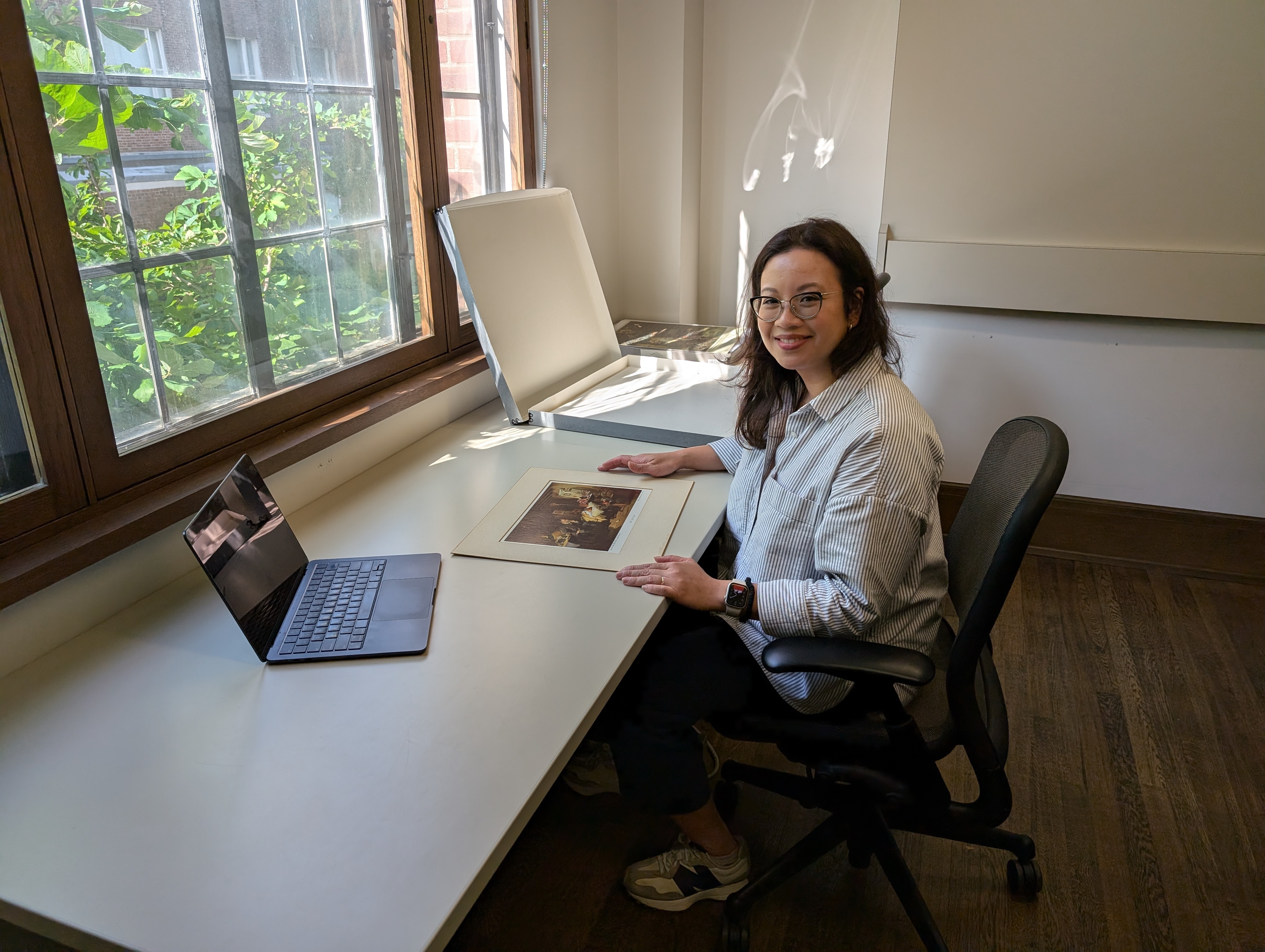By Hannah Darvin, 2024 Ferenc Gyorgyey/Stanley Simbonis YSM’57 Research Travel
I first came across Luke Fildes’s The Doctor while visiting Tate Britain as an art history student. I was struck by its size and subject matter. Measuring over 6 feet high and 9 feet wide, it depicts a child on the precipice of death, watched over intently by a physician who is prominently lit and placed at the center of the scene. His elevated social standing is articulated through his clothing, particularly his starched white collar, contrasting starkly with the humble cottage interior where the child lies on a makeshift bed of two mismatched chairs. In the dimly lit background, the child’s father places his hand on his weeping wife’s shoulder as he looks stoically at the scene. Years after my first encounter with this picture, I still found it beautiful and its appeal to my emotions fascinated me; it made me feel sad at the family’s plight but also hopeful that the care and attention from a physician might mean that the little patient might recover. Later, I learned that within art history, maudlin Victorian narrative pictures such as this should be viewed with suspicion and relegated to the category of “bad art.” This was largely due to modernist theorists who identified The Doctor as the height of sentimental Victorian genre painting, with Clive Bell declaring the painting as “worse than nugatory because the emotion it suggests is false.”[1] As a result of this position developed by modernist critics, art historians were long reluctant to critically engage with this picture.
From the moment of its creation, however, The Doctor was almost immediately adopted and at times co-opted by the medical establishment to perform an ideological function in both Britain and the United States. Fildes’s portrayal was ceaselessly evoked, reproduced and disseminated well into the twentieth and twenty-first centuries and came to function as an idealized vision of modern medicine. More recently, physicians writing in contemporary medical journals have re-imagined this painting to express frustrations and critique the increasing bureaucracy and burnout experienced by physicians at all levels.[2] Other physicians have marshalled reproductions of the painting as a physical token passed from mentor to student, prompting reflection about their own medical practice and highlighting the importance of the physician-patient relationship.[3] Moreover, this image has also been reworked by physicians to acknowledge the limits of medical intervention and to embrace the “human experience” of medical work; for some physicians, The Doctor has come to represent the importance of simply bearing witness to patients’ experiences of illness and death.[4] In medical circles, The Doctor has become synonymous with a professional ideal, underscoring the importance of care, attentiveness, concern, and empathy within the physician-patient relationship and the medical encounter more generally.
This past August, with the aid of the Ferenc Gyorgyey/Stanley Simbonis YSM’57 Research Travel Grant I was able to travel to Yale where I had the privilege of conducting archival research for my dissertation, Sentimentalizing Medicine: Luke Fildes’s The Doctor (1891) and the Idealized Image of the Physician-Patient Relationship. This grant supports scholars from Canada and the United States who wish to use the Harvey Cushing/John Hay Whitney Medical Library’s historical collections. My dissertation focuses on how The Doctor by Sir Luke Fildes, R.A., visually constructed the clinical interaction between doctor and patient. I concentrate on how, from the moment of its creation and subsequent exhibition, reimaginings, and dissemination through reproductions, The Doctor was mobilized to prime British and American medical professionals and publics on what to expect from a rapidly changing physician-patient relationship. My dissertation considers how The Doctor has continued to harness the emotions of nineteenth-, twentieth-, and twenty-first-century viewers, constructing an ideal physician-patient relationship in service of promoting and justifying medical modernity.
As the Ferenc Gyorgyey/Stanley Simbonis research fellow, I was able to examine “The Doctor” by Sir Luke Fildes collection (MS Coll 69). This collection is composed of multiple gifts from Bert Hansen, historian of medicine and gift of Dr. William Sherman and holds a wealth of material culture, print reproductions, decorative objects and medical texts related to my dissertation and my interest in how physicians have called upon The Doctor throughout the past 130 years to cultivate their own public and private constructions of professional identity. A particularly potent example from this holding is a miniature sculpture by Prescott Baston mass produced by Sebastian Miniatures between 1938 and 1976 (Fig. 1). The sculpture masterfully distills the original painting to two figures: the physician and patient. The lamp’s shade is tilted slightly, functioning as visual mechanism to direct the viewer’s gaze to the physician’s uninterrupted clinical attention before it moves to the patient. The figures are set on a pedestal, on which the words “THE DOCTOR” are inscribed. Measuring 3 x 2 x 2.5 inches, Sebastian Miniatures also circulated this sculpture as a pen stand and a pen stand paper weight. This series was one of the most popular sculptures produced by the company and it is estimated to have sold quantities in the tens of thousands.[5] It would be easy to dismiss this object as mawkish or kitschy; however, its legibility, portability, and ability to be placed in any space is precisely what makes it a powerful ideological tool. It effectively harnesses the viewer’s sentiment, deftly instructing doctors, patients, and family members on expected roles and behaviours within modern and contemporary medical spheres.
As an art historian working on an interdisciplinary project drawing on the histories of medicine and the critical medical humanities, the Ferenc Gyorgyey/Stanley Simbonis research fellowship provided a unique opportunity to discuss my project outside of my own discipline; I was able to have collaborative conversations on how my project might be received by medical historians, particularly at an institution embedded within a medical school which such rich history. Moreover, as a doctoral and early career researcher, I benefited immensely from the support of the administrative staff who assisted me throughout my visit as well as the archival team whose enthusiasm for my project and knowledge of the collection allowed me to explore my interest in the doctor-patient relationship more widely through the Harvey Cushing/John Hay Whitney Medical Library’s historical collections.
[1] Roger Fry, A Roger Fry Reader, ed. Christopher Reed (Chicago: University of Chicago Press, 1996), 320.
[2] In this reimagination, Eberly creates a diptych which physically separates the patient and physician. On the right panel, the patient lies alone on a hospital bed. On the left panel, the physician remains in his engaged, thoughtful pose but leans over a computer screen. John Brewer Eberly, “Modernizing Sir Luke Fildes’ The,” AMA Journal of Ethics 22, no. 5 (May 2020): E437-438.
[3] An example of this can be seen in Jane Moore, “What Sir Luke Fildes’ 1887 Painting The Doctor Can Teach Us about the Practice of Medicine Today,” British Journal of General Practice 58, no. 548 (2008): 210–13.
[4] Ian J. Barbash, “Silent Space,” JAMA 320, no. 11 (September 18, 2018): 1105.
[5] Glenn S. Johnson, The Sebastian Miniatures Collectors Guide (Worcester, Massachusetts: Commonwealth Press, 1980), 82–83.



